Raspberry: planting and care, growing and diseases
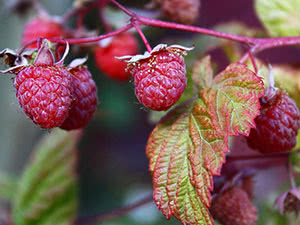 Raspberry plant or red raspberry (lat. Rubus idaeus) is a shrub in the genus Rubus of the rose family. The genus is represented by approximately six hundred species. Many of them were already known in the ancient world: the first mentioning about raspberry fruit can be found in the writings of the third century BC. Raspberry cultivation began in Western Europe in the sixteenth century AD. In the wild raspberry typically grows in forests, along rivers and it became one of the most popular and beloved garden berries many centuries ago.
Raspberry plant or red raspberry (lat. Rubus idaeus) is a shrub in the genus Rubus of the rose family. The genus is represented by approximately six hundred species. Many of them were already known in the ancient world: the first mentioning about raspberry fruit can be found in the writings of the third century BC. Raspberry cultivation began in Western Europe in the sixteenth century AD. In the wild raspberry typically grows in forests, along rivers and it became one of the most popular and beloved garden berries many centuries ago.
Today, perhaps, there is no garden without raspberry – tasty and flavorful berry that is a supply of necessary acids, minerals and vitamins. In addition to all its undeniable benefits, raspberry growing in the garden is unpretentious as it can grow and bear fruits even in desolation, but a proper care will help you increase the raspberry yield and protect it from pests and diseases.
Description of raspberry bush
Among gardeners a fruit of raspberry bush is as popular as gooseberries, currants, strawberries and other cultures that are tasty and healthy for the human body. It is grown not only for personal purposes and needs, but also for sale, so the quantity and quality of raspberry fruits are of a paramount importance. Red raspberry is a deciduous semi-shrub, reaching from 3.3 up to 6.6 feet in height. A woody raspberry root has lots of adventitious roots forming a powerful branching root system. Stems are erect, young raspberry shoots are herbaceous, succulent, green, covered with a bluish deposit and many small thorns. In their second year stems become woody, turn brown, wither after fruiting, but the next year new shoots take their place. Raspberry leaves are alternate, petiolate, oval, compound, with from three to seven ovate leaflets, the upper surface of the leaf is dark green, the underside is whitish due to the pubescence. White flowers are no more than 0.4 inch in diameter. They are assembled in the apical axillary truss. The berries that usually appear in the second year of growth are merged into an aggregate fruit of small sized hairy drupes of all shades of crimson, as well as yellow or black and maroon ( black raspberry varieties). Remontant raspberry was cultivated to bear fruit in the first year and produce two yields during the summer. Such raspberry species as blackberry and bramble form long shoots that are attached to the support by means of thorns located on the shoots. Wineberry and stone bramble belong to herbaceous raspberry species. Growing and caring for raspberries do not cause problems, but before breeding this berry in your garden you need to know the agrotechnical requirements and our simple and important tips on how to plant raspberry, what fertilizers should be applied, how to prune raspberry, in short, how to grow raspberry in the garden properly.
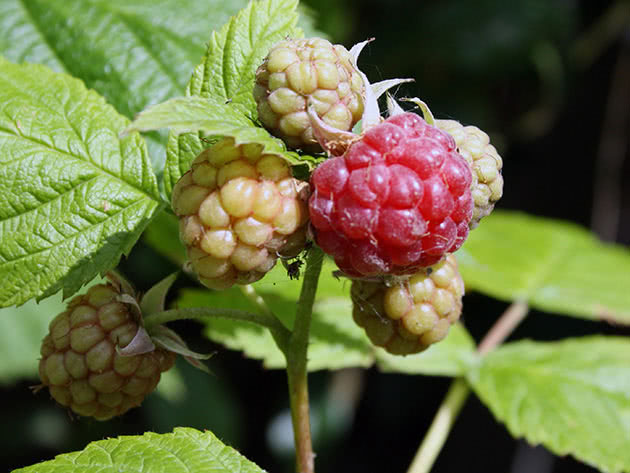
Raspberry planting
When to plant raspberry
Raspberries can be planted in autumn (September-October) and in spring as well. Being a light demander, raspberry needs an ample sunlight, and if you plant it in the shade, the young shoots will get overstretched shading stems with fruits. As to the soil, each variety has its own preferences, but typically raspberry needs light fertile soil, although it normally grows in black and loam soils. Optimal pH value is 5.7-6.5. Neither lowland, nor upland, and nor steep slopes are suitable for the cultivation of raspberries as moisture usually stagnates in bottomland and on uneven terrain sites, while in the upland, on the contrary, raspberry lacks for moisture. Flat or slightly slant places are the best choice for raspberry planting. At one site raspberry can grow from seven to ten years, and then it will be necessary to replant it as the soil with raspberry gets exhausted for a such period of time. Planting of raspberry at this place should be avoided for the next 5-7 years. The sites with such predecessors as solanaceae (tomatoes, potatoes, peppers) are strongly unrecommended. The best predecessors are beans or cereal crops.
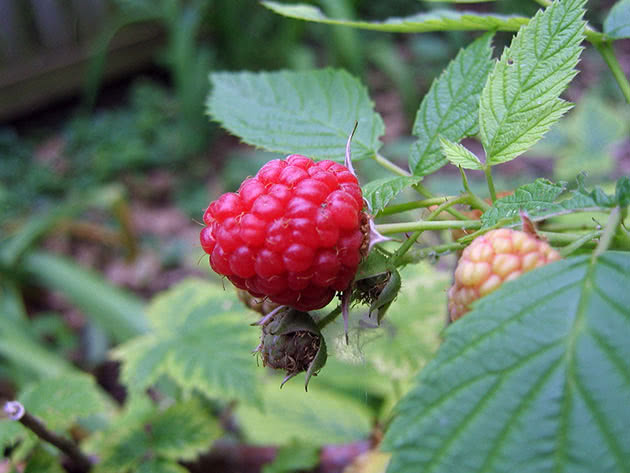
Raspberry planting in spring
The order of raspberry planting does not depend on the time of the year, but preparation for planting differs in spring and autumn. In early spring dig a planting hole in the size of 20x16x16 inches, putting upper fertile layer aside. The distance between the holes in the same row should be at least 20 inches, and between the rows the distance should be no less than 5 feet. Mix the top layer of the soil with a fertilizer, put some of this mixture into the hole, and leave the rest nearby. For each planting hole, you will need 22 pounds of manure or compost, 1.8 oz of potassium sulfate, 14 oz of wood ash and 3.5 oz of granulated superphosphate. If prior to planting a mixture in the hole got compressed, loosen it, set a raspberry seedling in the hole to place a bud of displacement slightly below the surface, carefully spread the roots out, fill up the hole with soil, pack it, then make a shallow furrow around the seedling and fill it with water. When water is absorbed, fill the furrow with humus, sawdust or dry straw, and cut the seedling at a height of 12 inches above the ground level. In a few days, if during that time there is no rain, water the raspberry seedlings again. The disadvantage of spring planting of raspberry is that due to weather conditions the seedlings can be planted not in time, and then the survival chances of seedlings are sharply decreased. For spring planting of raspberry, you can use the purchased planting stock or one that was dug out in autumn and winter stored in the refrigerator.

Raspberry planting in autumn
You should start preparing a site for raspberry a month and a half prior to planting. Dig the soil at the depth to which the spade will go, removing the weeds and adding 2-3 buckets of rotted manure per 11 square feet, 7-14 oz of superphosphate and 4-7 oz of potassium sulfate. This dressing will be enough for about five years. If the soil is peat, add 4 buckets of sand per 11 square feet. The best time for raspberry planting is the end of September or beginning of October. Autumn planting is preferable to spring one since you can slowly and carefully prepare the site, and besides, seedlings have enough time to take root before frosts, and when spring comes they start growing rapidly.
Care for raspberry
Spring care for raspberry
How to care for raspberry in spring? The first thing to do when the snow has melted away is to remove last year's foliage from the site as pests and pathogens of viral and fungal diseases could overwinter in it. Raspberry bushes need support, and for this purpose in spring raspberry is tied to a trellis. Growing raspberry on a trellis provides an adequate exposure of bushes to sunlight, facilitates care for them, accelerates the growth and maturation of new basal shoots. In order to construct a trellis, at the beginning and the end of each row at each side solid sticks of 3.3 feet in height are digged up and two lines of wire are stretched between them: the first one is at the height of 2-2.3 feet from the ground, the second one is at the height of 4 feet. Sticks are put into the soil every 16 feet for the wire not to sag. Raspberry shoots are spread over the wire in the semicircle and tied to it with a string. In two years, two more lines of the wire are stretched between the sticks, the first one is at the height of 12 inches from the ground level, the second one is at the height of 5 feet.
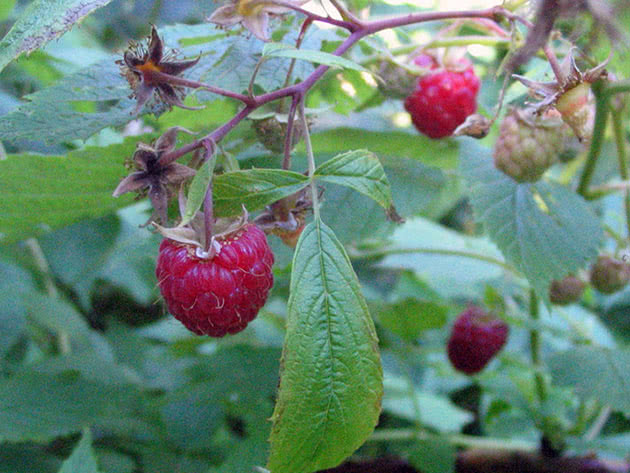
The following care for raspberry implies a regular weeding, shallow hoeing of the soil around the bushes with its subsequent mulching, watering and fertilizing. How to fertilize raspberries in spring? If when planting you used phosphorus-potassium fertilizers, there is no need to use them for a few years. However you will have to feed raspberry with nitrogen fertilizers annually. Raspberry fertilizing in spring consists of one bucket of water with one shovel of cow dung and 0.17 oz of ammonium nitrate or calurea poured under every bush at the end of March or early April. You can use other nitrogen fertilizer at the rate of 0.7-0.8 oz per 11 square feet. Do not forget to loosen the soil at the site after fertilizing.
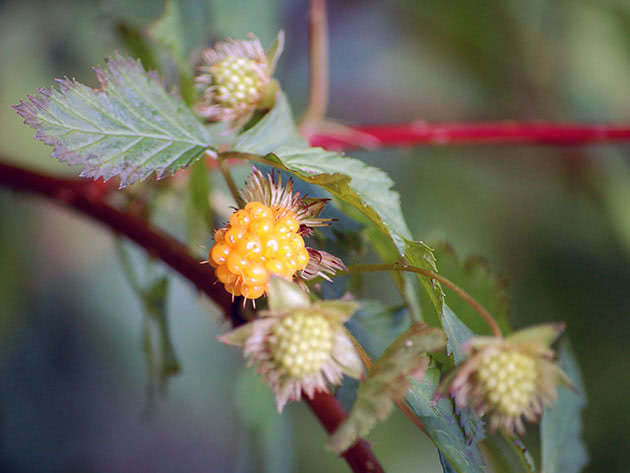
Autumn care for raspberry
In autumn, after collecting the harvest, it is very important to create good conditions for raspberry bushes to overwinter for you to have a rich harvest the next year. Mulch that was on the site throughout the summer should be removed and burned along with the indwelling pests, the soil should be carefully dug over no deeper than 3-4 inches. Every two years you should add compost and wood ash. Nitrogen fertilizer is not applied in autumn as it can provoke a strong growth of young shoots that fall the leaves later and they can get frostbitten. If you need to completely fertilize the site, then add potash and phosphate fertilizers in the furrow of 6-8 inches deep that is made no closer than 12 inches from the bush. The dose is no more than 2 oz of superphosphate and 1.4 oz of potassium salt under every bush. This dressing will facilitate forming of flower buds that will increase next year's harvest.
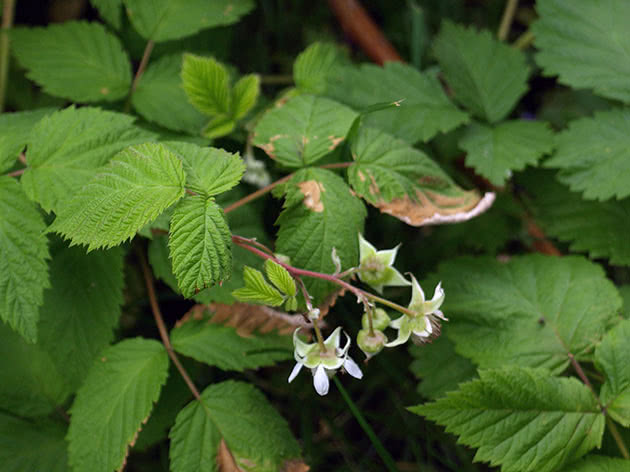
Watering of raspberry
With the normal amount of precipitation there is no need to water raspberry as in spring and summer raspberry needs watering only in case of drought. In dry and sultry weather raspberry should be watered abundantly to make a topsoil layer wet to a depth of 12-16 inches. Especially moisture is needed by raspberry in May, before flowering and during the growth and ripening of berries. But the most important watering is before winter since in autumn raspberry forms growth points of shoots in the roots, and the deeper you moisture the soil, the better raspberry overwinters. Drip irrigation is one of the best method of raspberry watering: first of all, it considerably saves water compared with ditch or sprinkler irrigation, and secondly, the water that is supplied to the roots, is already preheated (raspberry should not be watered with a cold water!) and, thirdly, the soil gets wet evenly. Keep in mind that mulching of the the soil at the raspberry patch reduces the need for moisture during the spring-summer season in 3-4 times.
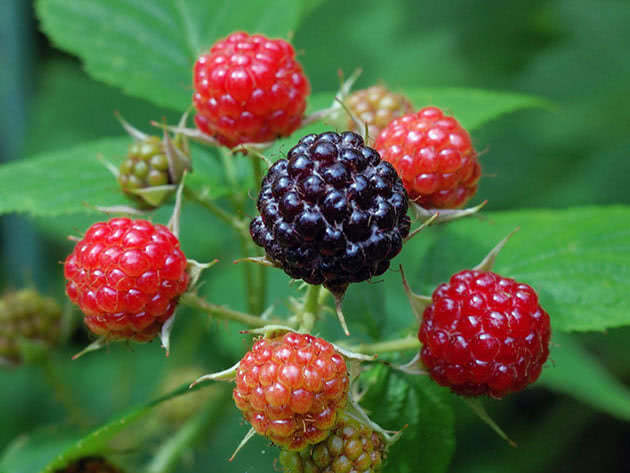
Raspberry replanting
We have already described you how to plant raspberry. Transplanting of raspberry is carried out by the same way as the primary planting. Raspberry bushes tend to grow extensively. During summer lots of new shoots suckers grow off the roots that are placed very closely to the ground surface. The new shoots can be cut by a shovel together with the roots of the bush and replanted. Younger part with the soil clod and roots can be cut out by a shovel from the old bush. The diameter of the young stems should be no less than 0.4 inch, and height of the seedlings should be up to 10 inches. Transplanting can be carried out at any time of the year except winter but the best time is spring. And for raspberry not to grow all over the garden the sheets of slate or iron should be put into the soil around the perimeter of the patch.
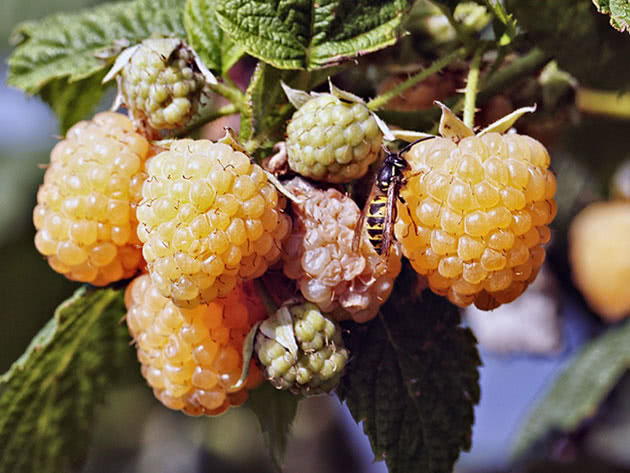
Raspberry propagation
As you see, raspberry planting and care for it are easy. Raspberry propagation is also very simple, especially if you know how to do it. We have already described how to propagate raspberry by root suckers. Now we will tell how to propagate raspberry by stem cuttings. In cloudy weather in June clip raspberry cuttings 4-5 inches long with two or three leaves from 2-3 year old root suckers, place them in a rooting hormone for a half-day, and then plant them in the containers with one pint of mixture of peat and sand and cover with the foil, keep the temperature between 72-77 ºF and a humidity level of about 90%. In a month, when the cuttings begin to grow, they are gently replanted with a clod of soil into a large container at least 5.5 inches height and about 2.6 pints in volume. As soon as they adapt, you should begin to gradually accustom them to the outside air, and when they got adapted, you need to transplant them to the temporary beds with a shade until they take root and begin to grow again. In autumn they are planted into permanent beds. If you clip cuttings in autumn, treat them with fungicide against fungal diseases, put them into peat and place in a basement, cellar or any other cool place for stratification until spring, periodically moistening peat. In spring cuttings can be planted into the beds with soil mulched around them.
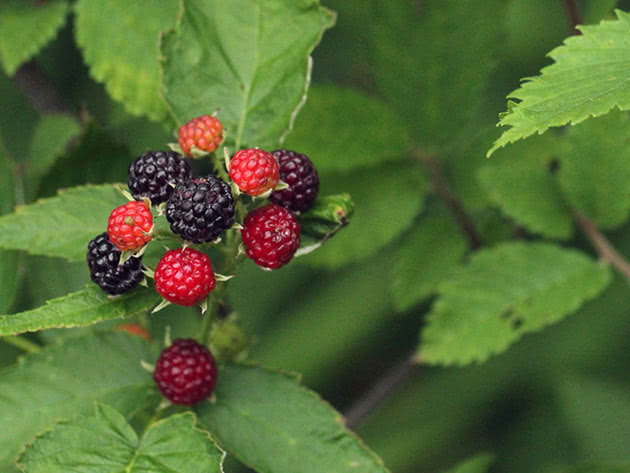
There are some species of raspberries that is propagated by tip layering like blackberries. They are purple and black raspberries. When in early autumn the shoot begins to bend to the ground, the leaves on its top get smaller, and it takes the form of a loop, it is the time to root it. Cut off such a shoot, along with "hand", and you get the planting material that can be rooted using already described method.
Raspberry pruning
Spring raspberry pruning
Spring care for raspberry implies pruning of frostbitten shoots up to healthy buds, as well as the removal of the sick, broken and underdeveloped branches. According to agro-technical rules, there should be 10-15 shoots per 3.2 feet of raspberry patch, so you should leave the shoots that started growing first and the rest should be removed. The shoots should be shortened by 6-8 inches. Do not worry that fewer shoots will give smaller number of berries, instead the berries will be large. You can certainly prune raspberry in autumn, but after winter you will still have to remove frostbitten bushes or broken branches. In addition, a well-known scientist Kazakov I.V. believes that spring pruning of raspberries increases the yield.
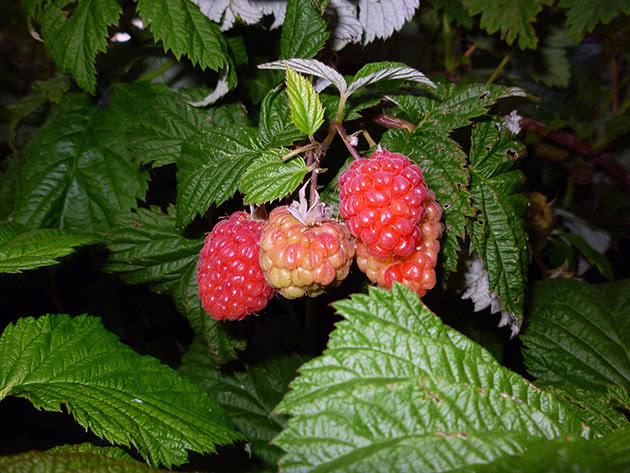
Autumn raspberry pruning
In autumn, as a rule, when the harvest has already been collected, two-year shoots are cut off as they will not bear fruits the next year. In any case they have to be removed, so do not put it off until spring making the plant supply unnecessary shoots. You should remove all shoots that produced fruits. If you do not grow remontant varieties of raspberries, then do not postpone pruning until late fall as you will have what to do in this time. Prune the raspberry when it stopped bearing fruits and it will use the resources for growing young shoots that will harvest the next year. Remontant varieties of raspberries are pruned after the second harvest. All cut shoots should be burned to destroy the insects, their larvae and pathogens that can live in them.
Raspberry in winter
Before we will tell you what to do with a raspberry with the onset of the winter, you should know what not to do in any case: it is a big mistake to tie and leave the raspberry bushes standing for winter as it can cause freezing of flower buds that are above the snow. Raspberry bushes need to be bent down to the ground as low as possible and fixed in this position to the trellis’ lowest wire. Remove the leaves from the shoots by moving a hand in a mitten upwards (but not vice versa as you will damage flower buds!). Preparing of raspberry bushes for winter pursues one goal: raspberry should be all under the snow. If the snow is not enough to cover the entire lying bush, you have to add more snow.
But that's not all. You should make sure that raspberry has access to the air by puncturing ice crust formed on the snow. And if there is no snow in winter at all, you should cover raspberry bushes by frost protecting material. When spring comes, the cover is removed, but the bushes are not lifted at once: you must first determine and remove the damaged shoots, and only then raise overwintered shoots and fix them to the trellis.

Raspberry diseases and their treatment
Raspberry gets yellow
The readers who grow raspberries on their sites often ask what measures are necessary to be taken to protect raspberry from disease. For example, why does raspberry turn yellow, to be more precise, why do its leaves turn yellow and fall off? If raspberry leaves turn yellow, then it is affected by one of three diseases – rust, crown gall or chlorosis. Crown gall is an incurable diseases and it manifests itself by swellings on the roots, tasteless berries, too short stems and leaves yellowing and falling. Affected bushes need to be dug up and burned, and nothing should be planted on that patch of land for at least eight years. Rust is also an unpleasant diseases. In May raspberry leaves start drying out, turning yellow and falling off, the shoots are covered with dark sores. If the diseases is at its advanced stage, then affected bushes also need to be dug out and destroyed. But if the disease is noticed in time, a processing of raspberry bushes by one percent solution of Bordeaux mixture can help. Chlorosis is a viral disease that is often caused by the aphid. It is aphid you must control. Affected plant has smaller and deformed leaves, its shoots do not develop, berries become dry and unsuitable for food. Sometimes chlorosis is caused not by aphids but by the lack of microelements in the soil, cold watering of raspberry, too much moisture in the soil or the soil at the site is too alkaline. Find out the reason of chlorosis and eliminate it.

Raspberry withers
Sometimes the reason of drying leaves is insufficient or untimely watering since raspberry is a water-loving plant. But if watering is adequate, inspect the dried leaves, and if you find them thickened, then a bush is affected by midge. Its larvae create galls on the leaves of raspberry. All affected stems should be cut down to the roots, leaving no stumps, and be destroyed. Purple spotting can also cause drying of leaves. It is a fungal disease that begins with the appearance of red-brown spots on the leaves and then they wither. After collecting the harvest you should apply the drugs that contain phytohormones. Dried shoots should be cut to the root immediately upon the disease detection without waiting until the fall.
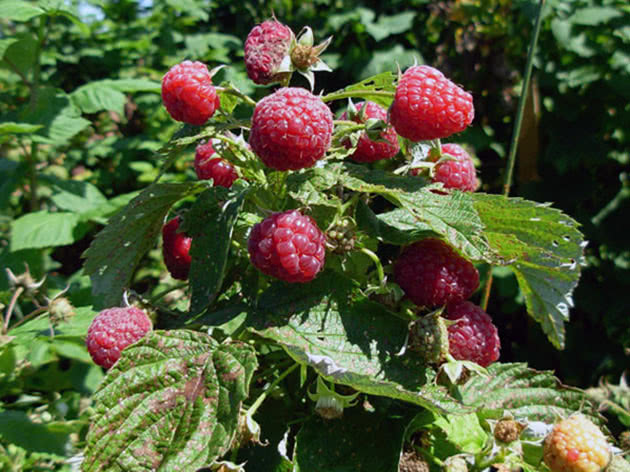
Anthracnose of raspberry
If the berries, not the leaves, get dry, gray spots with a red border are formed on the leaves and the tips of the stems die, you deal with the fungal disease anthracnose affecting raspberry in a humid summer. Anthracnose can be avoided by planting varieties that are resistant to fungi and by removing and destroying infested parts of the plant. Pathogenic fungus can be removed by spraying of raspberry bushes with a fungicide.
Raspberry pests and their control
The raspberry can be affected by aphids, spider mites, cane midge, weevil, gall fly, raspberry beetle and raspberry sawfly. Raspberry beetle has yellow-brown color and it affects flowering raspberry: the insect eats the flowers, buds and leaves, the female lays the eggs in the flowers, and then larvae eat the harvest. The pest is controlled by the processing of the raspberry bushes with a fungicide immediately after snow melting, during flowering you can apply an insecticide. Raspberry sawfly lays its larvae in the axils of upper leaves, and hatched larvae eat raspberry shoots. Cane midge and gall fly lay eggs in the young shoots that then they are eaten by the larvae. The signs of aphids are honeydew on the leaves and shoots of raspberry, twisted leaves, deformed shoots. In addition, the aphid is a carrier of diseases. Spider mites suck plant sap infecting it with botrytis spores and viral infections. The female weevil lays eggs in the buds of raspberry flowers and in such a way it gnaws the peduncle. One insect is able to damage up to fifty flowers. A means of controlling of all these insects is applying of insecticides in early spring and after collecting of harvest. But as a preventive measure you should steadily and timely follow agro-technical rules of raspberry cultivation not to deal with pests and diseases of raspberry.

Raspberry varieties
Raspberry varieties are divided into traditional, large-fruited and remontant. Traditional varieties are reliable, have a high degree of adaptability to soil and climatic conditions, but do not have a high yield. Large fruited varieties have large and the most flavorful berries, and their shoots are well able to branch that contributes to higher yields. Remontant raspberry bears fruits twice in a season until strong frosts. In their turn, varieties of all these species differ by maturity season, taste quality, color of berries, as well as by their resistance to pests and diseases.
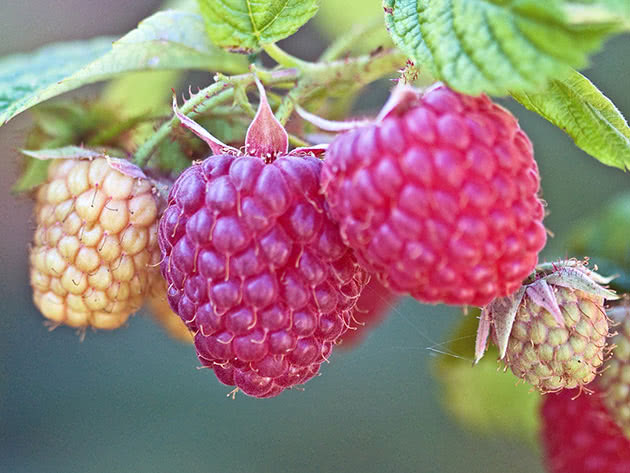
Early season raspberry varieties:
- Cascade is a mid season shrub with weak thorns that reaches up to 6.5 feet in height. The berries weights up to 0.1 oz. They have a blunt-ended form, sour-sweet taste and dark red color. It does not tolerate drought and it tends to be affected by spotting;
- Cumberland is a black raspberry variety. Its berry weights up to 0.07 oz, the bush is up to 6.5 feet in height with arcuately curved shoots. Root suckers are not formed. It is moderately hardy, resistant to diseases and pests;
- Golden Giant is an yellow raspberry. It is a high-yielding, large-fruited, hardy variety. Its berries weight from 0.3 to 0.5 oz;
- Vega is a bush up to 8.5 feet high. It forms a large number of shoots with weak thorns. The berries have a blunt-ended form, crimson color and sweet-sour taste. Their weight is up to 0.14 oz. This variety is hardy and resistant enough to fungal diseases;
- Glen Ample is an English variety. It is a strong variety with well branching shoots that are up to 11.5 feet in height. This high-yielding variety is hardy and resistant to diseases and pests. 15 tons of dense berries can be collected from 2.5 acres. The berries have a rounded-conical shape, bright red color and weigh up to 0.14 oz.

Mid season raspberry varieties:
- Ruby is a shrub of up to 6 feet in height. The shoots are with numerous short dark purple thorns, berries weigh up to 0.1 oz and have blunt-ended shape and bright red color. It is a winter-hardy variety, but can be affected by anthracnose;
- Mirage is a variety of average height with soft, small, short thorns of dark red color. The berries are large and weigh up to 0.2 oz. The shape of berries is elongated, the color is red. The variety is resistant to diseases and pests.
- Capital is a compact erect shrub up to 6.5 feet high with large red berries weighing up to 0.3 oz. The yield is up to 8.8 pounds of fragrant berries from a bush. The variety is hardy and resistant to disease;

Remontant varieties:
- Orange Miracle is an orange raspberry of a high palatability. The weight of the elongated shiny berries is 0.2-0.3 oz, the taste is sweet and sour. The variety is resistant to fungal diseases and pests;
- Apricot is a golden raspberry with a delicate aroma. The berries have a blunt ended shape and weigh up to 0.1 oz.
- Mulatto is a very high-yielding variety with bright round fruits of sweet-sour taste, dark-cherry color, weighing up to 0.1 oz. The variety has a high resistance to pests and fungal diseases;
- Diamond is a high yielding variety one bush of which can produce up to 6.6 pounds of berries. Berries are large weighing up to 0.2 oz. The shape of berries is conical, the color is ruby with bright luster. The taste is sweet and sour. It is a dessert variety.
Raspberry properties
Raspberry fruits contain fructose, organic acids (citric, malic, tartaric, ascorbic, formic, hexanoic), as well as vitamins and trace elements ( magnesium, iron, potassium, calcium and phosphorus). Raspberries have long been used as a remedy for colds by brewing tea from dried berries, using it as a jam or frayed with sugar. Unlike other berries, raspberry does not lose its medicinal properties after heat processing. The infusion and decoction of raspberry leaves are recommended to treat cough or sore throat. The infusion of flowers and leaves is recommended for gynecological diseases and hemorrhoids. The drugs made of flowers, fruits and raspberry leaves have anti-sclerotic, antipyretic, anti-inflammatory, antioxidant actions and are used to treat colds, atherosclerosis, hypertension, diabetes, anemia, heart rhythm disorders, kidney diseases.

East medicine uses raspberry for treatments of infertility and impotence.
The infusion of the raspberry leaves is used for treatment of eczema, acne, rashes and erysipelas by wiping the skin. To treat blepharitis and conjunctivitis eye lotion is made from the infusion. Decoction of raspberry roots stops nasal and hemorrhoidal bleedings and treat purulent otitis.
Recently, experts from Clemson University have conducted a study that helped find another remarkable property of raspberries. A raspberry extract was given to the animals with cancer and the researchers found that 90% of cancer cells died due to the action of this drug. None of known antioxidant demonstrates such a result. And any variety of raspberry can cope with a tumor.
However, those who decided to test the healing properties of raspberry should know that it is contraindicated during exacerbation of gastritis, duodenal and gastric ulcer, as well as for patients with gout, nephritis, and amyloidosis.
